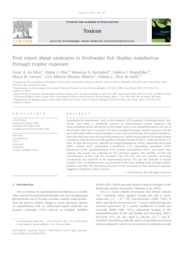First report about saxitoxins in freshwater fish Hoplias malabaricus through trophic exposure.
First report about saxitoxins in freshwater fish Hoplias malabaricus through trophic exposure.
Autoria: SILVA, C. A. da; OBA, E. T.; RAMSDORF, W. A.; MAGALHÃES, V. F.; CESTARI, M. M.; RIBEIRO, C. A. O.; ASSIS, H. C. S. de
Resumo: Cyanobacterial waterblooms, such as the saxitoxin (STX) producer Cylindrospermopsis raciborskii, have been a worldwide concern in environmental health. However, the bioaccumulation of this neurotoxin in the trophic chain is not completely known. The aim of the present work was to evaluate STX bioaccumulation through chemical analyses and the toxic and trophic effects using biomarkers in the tropical freshwater fish Hoplias malabaricus. They were fed once every five days with Astyanax sp. before being subjected to intraperitoneal inoculation with STX extract (0.08 mg/100 g) obtained by lysis of toxic C. raciborskii strain (T3). After 20 days the brain was collected for acetylcholinesterase (AChE), superoxide dismutase (SOD), catalase (CAT), glutathione S-transferase (GST), glutathione peroxidase (GPx), glutathione (GSH), lipoperoxidation (LPO), protein carbonylation (PCO), and comet assay analysis. The muscle was collected for STX chemical analysis. The activities of SOD and concentrations of PCO and LPO increased. The CAT, GST, and GPx activities decreased. Genotoxicity was observed in the experimental group. STX was not detected in muscle samples. Thus, an oxidative stress was observed in the brain, leading to the damage of lipids, proteins, and DNA. The mechanism of action of the neurotoxin in this subchronic exposure suggests an apoptotic cellular process.
Ano de publicação: 2011
Tipo de publicação: Artigo de periódico
Unidade: Embrapa Amapa
Palavras-chave: Peixe de água doce, Toxina, Traíra
Observações
1 - Por padrão são exibidas publicações dos últimos 20 anos. Para encontrar publicações mais antigas, configure o filtro ano de publicação, colocando o ano a partir do qual você deseja encontrar publicações. O filtro está na coluna da esquerda na busca acima.
2 - Para ler algumas publicações da Embrapa (apenas as que estão em formato ePub), é necessário ter, no celular ou computador, um desses softwares gratuitos. Sistemas Android: Google Play Livros; IOS: iBooks; Windows e Linux: software Calibre.
Acesse outras publicações
Acesse a Base de Dados da Pesquisa Agropecuária (BDPA) para consultar o acervo completo das bibliotecas da Embrapa.

